Subsidence in Qinghai—Tibet Plateau Peatlands Driven by Drainage Disturbance and Climatic Variability
Abstract
1. Introduction
2. Materials and Methods
2.1. Study Area
2.2. SAR Data
2.3. Peatland Classification Using Multi-Source Remote Sensing
2.4. InSAR Processing and Deformation Retrieval
2.5. Accuracy Assessment
2.6. Analysis of Subsidence Drivers
3. Results
3.1. Peatland Classification Accuracy
3.2. SBAS-InSAR Accuracy Evaluation
3.3. Seasonal Patterns of Subsidence
3.4. Interannual Patterns of Subsidence
3.5. Drivers of Peatland Subsidence
4. Discussion
4.1. Anthropogenic Drivers and Mechanisms of Subsidence
4.2. Climatic Modulation and Seasonal Feedback
4.3. Management Implications and Regional Strategies
5. Conclusions
Supplementary Materials
Author Contributions
Funding
Data Availability Statement
Conflicts of Interest
References
- Page, S.E.; Baird, A.J. Peatlands and global change: Response and resilience. Annu. Rev. Environ. Resour. 2016, 41, 35–57. [Google Scholar] [CrossRef]
- FAO. Peatlands Mapping and Monitoring—Recommendations and Technical Overview; FAO: Rome, Italy, 2020. [Google Scholar] [CrossRef]
- Xu, J.R.; Morris, P.J.; Liu, J.G.; Holden, J. PEATMAP: Refining estimates of global peatland distribution based on a meta-analysis. Catena 2018, 160, 134–140. [Google Scholar] [CrossRef]
- Yu, Z.C.; Loisel, J.; Brosseau, D.P.; Beilman, D.W.; Hunt, S.J. Global peatland dynamics since the last glacial maximum. Geophys. Res. Lett. 2010, 37, L13402. [Google Scholar] [CrossRef]
- Acreman, M.; Holden, J. How wetlands affect floods. Wetlands 2013, 33, 773–786. [Google Scholar] [CrossRef]
- Flood, K.; Wilson, D.; Renou-Wilson, F. Evidence synthesis and knowledge integration for sustainable peatland management. Land 2025, 14, 1397. [Google Scholar] [CrossRef]
- Leifeld, J.; Menichetti, L. The underappreciated potential of peatlands in global climate change mitigation strategies. Nat. Commun. 2018, 9, 1071. [Google Scholar] [CrossRef] [PubMed]
- Fluet-Chouinard, E.; Stocker, B.D.; Zhang, Z.; Malhotra, A.; Melton, J.R.; Poulter, B.; Kaplan, J.O.; Goldewijk, K.K.; Siebert, S.; Minayeva, T.; et al. Extensive global wetland loss over the past three centuries. Nature 2023, 614, 281–286. [Google Scholar] [CrossRef] [PubMed]
- Ghezelayagh, P.; Oleszczuk, R.; Stachowicz, M.; Eini, M.R.; Kamocki, A.; Banaszuk, P.; Grygoruk, M. Developing a remote-sensing-based indicator for peat soil vertical displacement. A case study in the Biebrza Valley, Poland. Ecol. Indic. 2024, 166, 112305. [Google Scholar] [CrossRef]
- Hoyt, A.M.; Chaussard, E.; Seppalainen, S.S.; Harvey, C.F. Widespread subsidence and carbon emissions across Southeast Asian peatlands. Nat. Geosci. 2020, 13, 435–440. [Google Scholar] [CrossRef]
- Hrysiewicz, A.; Williamson, J.; Evans, C.D.; Jovani-Sancho, A.J.; Callaghan, N.; Lyons, J.; White, J.; Kowalska, J.; Menichino, N.; Holohan, E.P. Estimation and validation of InSAR-derived surface displacements at temperate raised peatlands. Remote Sens. Environ. 2024, 311, 114232. [Google Scholar] [CrossRef]
- Antonijević, D.; Hoffmann, M.; Zak, D.; Prochnow, A.; Dubbert, M.; Schmidt, M.; Augustin, J. Impact of plant succession on greenhouse gas fluxes during the transition of a flooded fen peatland. Commun. Earth Environ. 2025, 6, 611. [Google Scholar] [CrossRef]
- Sa, R.; Nie, Y.; Chumachenko, S.; Fan, W. Biomass estimation and saturation value determination based on multi-source remote sensing data. Remote Sens. 2024, 16, 2250. [Google Scholar] [CrossRef]
- Hooijer, A.; Vernimmen, R.; Mulyadi, D.; Triantomo, V.; Hamdani; Lampela, M.; Agusti, R.; Page, S.E.; Doloksaribu, J.; Setiawan, I.; et al. Benefits of tropical peatland rewetting for subsidence reduction and forest regrowth: Results from a large-scale restoration trial. Sci. Rep. 2024, 14, 10721. [Google Scholar] [CrossRef] [PubMed]
- Ikkala, L.; Ronkanen, A.K.; Utriainen, O.; Klove, B.; Marttila, H. Peatland subsidence enhances cultivated lowland flood risk. Soil. Tillage Res. 2021, 212, 105078. [Google Scholar] [CrossRef]
- Zanello, F.; Teatini, P.; Putti, M.; Gambolati, G. Long term peatland subsidence: Experimental study and modeling scenarios in the Venice coastland. J. Geophys. Res.-Earth Surf. 2011, 116, F04002. [Google Scholar] [CrossRef]
- Hasan, M.F.; Smith, R.; Vajedian, S.; Pommerenke, R.; Majumdar, S. Global land subsidence mapping reveals widespread loss of aquifer storage capacity. Nat. Commun. 2023, 14, 6180. [Google Scholar] [CrossRef]
- Hooijer, A.; Page, S.; Canadell, J.G.; Silvius, M.; Kwadijk, J.; Wösten, H.; Jauhiainen, J. Current and future CO2 emissions from drained peatlands in Southeast Asia. Biogeosciences 2010, 7, 1505–1514. [Google Scholar] [CrossRef]
- Minasny, B.; Adetsu, D.V.; Aitkenhead, M.; Artz, R.R.E.; Baggaley, N.; Barthelmes, A.; Beucher, A.; Caron, J.; Conchedda, G.; Connolly, J.; et al. Mapping and monitoring peatland conditions from global to field scale. Biogeochemistry 2023, 167, 383–425. [Google Scholar] [CrossRef]
- Sun, J.; Gallego-Sala, A.; Yu, Z. Topographic and climatic controls of peatland distribution on the tibetan plateau. Sci. Rep. 2023, 13, 14811. [Google Scholar] [CrossRef]
- Qiu, T.; Cong, N.; Rong, L.; Qi, G.; Du, L.; Ren, P.; Xiao, J. Spatiotemporal dynamics and driving mechanisms of alpine peatland wetlands in the eastern qinghai–tibet plateau based on a vision transformer model. Ecol. Indic. 2025, 178, 114136. [Google Scholar] [CrossRef]
- Guo, X.; Du, W.; Wang, X.; Yang, Z. Degradation and structure change of humic acids corresponding to water decline in zoige peatland, qinghai-tibet plateau. Sci. Total Environ. 2013, 445–446, 231–236. [Google Scholar] [CrossRef] [PubMed]
- Gao, J.H.; Holden, J.; Kirkby, M. The impact of land-cover change on flood peaks in peatland basins. Water Resour. Res. 2016, 52, 3477–3492. [Google Scholar] [CrossRef]
- Jaenicke, J.; Rieley, J.O.; Mott, C.; Kimman, P.; Siegert, F. Determination of the amount of carbon stored in Indonesian peatlands. Geoderma 2008, 147, 151–158. [Google Scholar] [CrossRef]
- Page, S.E.; Rieley, J.O.; Banks, C.J. Global and regional importance of the tropical peatland carbon pool. Glob. Change Biol. 2011, 17, 798–818. [Google Scholar] [CrossRef]
- Xiang, S.A.; Guo, R.Q.; Wu, N.; Sun, S.C. Current status and future prospects of zoige marsh in eastern qinghai-tibet plateau. Ecol. Eng. 2009, 35, 553–562. [Google Scholar] [CrossRef]
- Yule, C.M. Loss of biodiversity and ecosystem functioning in indo-malayan peat swamp forests. Biodivers. Conserv. 2010, 19, 393–409. [Google Scholar] [CrossRef]
- Zhong, Q.; Chen, H.; Liu, L.; He, Y.; Zhu, D.; Jiang, L.; Zhan, W.; Hu, J. Water table drawdown shapes the depth-dependent variations in prokaryotic diversity and structure in Zoige peatlands. FEMS Microbiol. Ecol. 2017, 93, fix049. [Google Scholar] [CrossRef]
- Canisius, F.; Brisco, B.; Murnaghan, K.; Van der Kooij, M.; Keizer, E. SAR backscatter and InSAR coherence for monitoring wetland extent, flood pulse and vegetation: A study of the amazon lowland. Remote Sens. 2019, 11, 720. [Google Scholar] [CrossRef]
- Khakim, M.Y.N.; Bama, A.A.; Yustian, I.; Poerwono, P.; Tsuji, T.; Matsuoka, T. Peatland subsidence and vegetation cover degradation as impacts of the 2015 El nino event revealed by sentinel-1A SAR data. Int. J. Appl. Earth Obs. Geoinf. 2020, 84, 101953. [Google Scholar] [CrossRef]
- Lees, K.J.; Quaife, T.; Artz, R.R.E.; Khomik, M.; Clark, J.M. Potential for using remote sensing to estimate carbon fluxes across northern peatlands—A review. Sci. Total Environ. 2018, 615, 857–874. [Google Scholar] [CrossRef]
- Merchant, M.A.; Adams, J.R.; Berg, A.A.; Baltzer, J.L.; Quinton, W.L.; Chasmer, L.E. Contributions of C-band SAR data and polarimetric decompositions to subarctic boreal peatland mapping. IEEE J. Sel. Top. Appl. Earth Obs. Remote Sens. 2017, 10, 1467–1482. [Google Scholar] [CrossRef]
- Mullissa, A.; Vollrath, A.; Odongo-Braun, C.; Slagter, B.; Balling, J.; Gou, Y.Q.; Gorelick, N.; Reiche, J. Sentinel-1 SAR backscatter analysis ready data preparation in google earth engine. Remote Sens. 2021, 13, 1954. [Google Scholar] [CrossRef]
- Oakes, G.; Hardy, A.; Bunting, P. Rad wet: An improved and transferable mapping of open water and inundated vegetation using sentinel-1. Remote Sens. 2023, 15, 1705. [Google Scholar] [CrossRef]
- De la Barreda-Bautista, B.; Ledger, M.J.; Sjögersten, S.; Gee, D.; Sowter, A.; Cole, B.; Page, S.E.; Large, D.J.; Evans, C.D.; Tansey, K.J. Exploring spatial patterns of tropical peatland subsidence in Selangor, Malaysia using the APSIS-DInSAR technique. Remote Sens. 2024, 16, 2249. [Google Scholar] [CrossRef]
- Tarigan, S.; Kristanto, Y.; Utomo, W.Y. Characterizing subsidence in used and restored peatland with Sentinel SAR data. Front. Environ. Sci. 2023, 11, 1088923. [Google Scholar] [CrossRef]
- Valman, S.; Siewert, M.B.; Boyd, D.; Ledger, M.; Gee, D.; De La Barreda-Bautista, B.; Sowter, A.; Sjögersten, S. InSAR-measured permafrost degradation of palsa peatlands in northern Sweden. Cryosphere 2024, 18, 1773–1790. [Google Scholar] [CrossRef]
- Chen, Y.; Yu, S.W.; Tao, Q.X.; Liu, G.L.; Wang, L.Y.; Wang, F.Y. Accuracy verification and correction of D-InSAR and SBAS-InSAR in monitoring mining surface subsidence. Remote Sens. 2021, 13, 4365. [Google Scholar] [CrossRef]
- Hussain, S.; Pan, B.; Hussain, W.; Sajjad, M.M.; Ali, M.; Afzal, Z.; Abdullah-Al-Wadud, M.; Tariq, A. Integrated PSInSAR and SBAS-InSAR analysis for landslide detection and monitoring. Phys. Chem. Earth Parts A/B/C 2025, 139, 103956. [Google Scholar] [CrossRef]
- Yao, J.M.; Yao, X.; Liu, X.H. Landslide detection and mapping based on SBAS-InSAR and PS-InSAR: A case study in gongjue county, Tibet, China. Remote Sens. 2022, 14, 4728. [Google Scholar] [CrossRef]
- Zhang, Z.; Hu, C.; Wu, Z.; Zhang, Z.; Yang, S.; Yang, W. Monitoring and analysis of ground subsidence in Shanghai based on PS-InSAR and SBAS-InSAR technologies. Sci. Rep. 2023, 13, 8031. [Google Scholar] [CrossRef]
- Gaffney, P.P.J.; Tang, Q.; Li, Q.; Zhang, R.; Pan, J.; Xu, X.; Li, Y.; Niu, S. The impacts of land-use and climate change on the Zoige peatland carbon cycle: A review. WIREs Clim. Chang. 2023, 15, e862. [Google Scholar] [CrossRef]
- Lei, J.J.; Zeng, C.L.; Zhang, L.; Wang, X.G.; Ma, C.H.; Zhou, T.; Laffitte, B.; Luo, K.; Yang, Z.H.; Tang, X.L. Prediction of soil organic carbon stock combining Sentinel-1 and Sentinel-2 images in the Zoige Plateau, the northeastern Qinghai-Tibet Plateau. Ecol. Process. 2024, 13, 32. [Google Scholar] [CrossRef]
- Liu, L.; Chen, H.; Zhu, Q.; Yang, G.; Zhu, E.; Hu, J.; Peng, C.; Jiang, L.; Zhan, W.; Ma, T.; et al. Responses of peat carbon at different depths to simulated warming and oxidizing. Sci. Total Env. 2016, 548–549, 429–440. [Google Scholar] [CrossRef]
- Weiss, M.; Jacob, F.; Duveiller, G. Remote sensing for agricultural applications: A meta-review. Remote Sens. Environ. 2020, 236, 111402. [Google Scholar] [CrossRef]
- McFeeters, S.K. The use of the normalized difference water index (NDWI) in the delineation of open water features. Int. J. Remote Sens. 1996, 17, 1425–1432. [Google Scholar] [CrossRef]
- Gitelson, A.A.; Merzlyak, M.N.; Chivkunova, O.B. Optical properties and nondestructive estimation of anthocyanin content in plant leaves. Photochem. Photobiol. 2001, 74, 38–45. [Google Scholar] [CrossRef]
- Hatfield, J.L.; Prueger, J.H. Value of using different vegetative indices to quantify agricultural crop characteristics at different growth stages under varying management practices. Remote Sens. 2010, 2, 562–578. [Google Scholar] [CrossRef]
- Baret, F.; Hagolle, O.; Geiger, B.; Bicheron, P.; Miras, B.; Huc, M.; Berthelot, B.; Niño, F.; Weiss, M.; Samain, O.; et al. LAI, fAPAR and fCover CYCLOPES global products derived from VEGETATION: Part 1: Principles of the algorithm. Remote Sens. Environ. 2007, 110, 275–286. [Google Scholar] [CrossRef]
- Du, Q.; Li, G.; Chen, D.; Qi, S.; Zhou, Y.; Wang, F.; Cao, Y. Extracting water body data based on SDWI and threshold segmentation: A case study in permafrost area surrounding Salt Lake in Hoh Xil, Qinghai-Tibet Plateau, China. Res. Cold Arid. Reg. 2023, 15, 202–209. [Google Scholar] [CrossRef]
- Umarhadi, D.A.; Avtar, R.; Widyatmanti, W.; Johnson, B.A.; Yunus, A.P.; Khedher, K.M.; Singh, G. Use of multifrequency (C-band and L-band) SAR data to monitor peat subsidence based on time-series SBAS InSAR technique. Land. Degrad. Dev. 2021, 32, 4779–4794. [Google Scholar] [CrossRef]
- Shi, S.H.; Wang, X.L.; Hu, Z.R.; Zhao, X.; Zhang, S.R.; Hou, M.; Zhang, N. Geographic detector-based quantitative assessment enhances attribution analysis of climate and topography factors to vegetation variation for spatial heterogeneity and coupling. Glob. Ecol. Conserv. 2023, 42, e02398. [Google Scholar] [CrossRef]
- Wang, J.F.; Li, X.H.; Christakos, G.; Liao, Y.L.; Zhang, T.; Gu, X.; Zheng, X.Y. Geographical detectors-based health risk assessment and its application in the neural tube defects study of the Heshun region, China. Int. J. Geogr. Inf. Sci. 2010, 24, 107–127. [Google Scholar] [CrossRef]
- Che, T. Long-Term Series of Daily Snow Depth Dataset in China (1979–2024); National Tibetan Plateau Data Center: Beijing, China, 2015. [Google Scholar] [CrossRef]
- Li, Z.W.; Gao, P.; Lu, H.Y. Dynamic changes of groundwater storage and flows in a disturbed alpine peatland under variable climatic conditions. J. Hydrol. 2019, 575, 557–568. [Google Scholar] [CrossRef]
- Li, Z.W.; Gao, P.; You, Y.C. Characterizing hydrological connectivity of artificial ditches in zoige peatlands of qinghai-tibet plateau. Water 2018, 10, 1364. [Google Scholar] [CrossRef]
- Oleszczuk, R.; Zajac, E.; Urbanski, J.; Jadczyszyn, J. Rate of fen-peat soil subsidence near drainage ditches (central poland). Land 2021, 10, 1287. [Google Scholar] [CrossRef]
- Liu, M.; Zhang, Z.C.; Sun, J.; Li, Y.R.; Liu, Y.; Berihun, M.L.; Xu, M.; Tsunekawa, A.; Chen, Y.J. Restoration efficiency of short-term grazing exclusion is the highest at the stage shifting from light to moderate degradation at Zoige, Tibetan Plateau. Ecol. Indic. 2020, 114, 106323. [Google Scholar] [CrossRef]
- Pan, T.; Hou, S.; Wu, S.H.; Liu, Y.J.; Liu, Y.H.; Zou, X.T.; Herzberger, A.; Liu, J.G. Variation of soil hydraulic properties with alpine grassland degradation in the eastern Tibetan Plateau. Hydrol. Earth Syst. Sci. 2017, 21, 2249–2261. [Google Scholar] [CrossRef]
- Brouns, K.; Eikelboom, T.; Jansen, P.C.; Janssen, R.; Kwakernaak, C.; van den Akker, J.J.; Verhoeven, J.T. Spatial analysis of soil subsidence in peat meadow areas in Friesland in relation to land and water management, climate change, and adaptation. Environ. Manag. 2015, 55, 360–372. [Google Scholar] [CrossRef]
- Ledger, M.J.; Sowter, A.; Morrison, K.; Evans, C.D.; Large, D.J.; Athab, A.; Gee, D.; Brown, C.; Sjögersten, S. Potential of APSIS-InSAR for measuring surface oscillations of tropical peatlands. PLoS ONE 2024, 19, e0298939. [Google Scholar] [CrossRef]
- Zahro, Q.; Izumi, Y.; Novresiandi, D.A.; Cahyana, D.; Widodo, J.; Ito, D.; Ota, K.; Dong, M. Tropical peatland restoration evaluation using time-series L-band InSAR analysis. Sci. Rep. 2025, 15, 23749. [Google Scholar] [CrossRef]
- Marshall, C.; Sterk, H.P.; Gilbert, P.J.; Andersen, R.; Bradley, A.V.; Sowter, A.; Marsh, S.; Large, D.J. Multiscale variability and the comparison of ground and satellite radar based measures of peatland surface motion for peatland monitoring. Remote Sens. 2022, 14, 336. [Google Scholar] [CrossRef]
- de Waard, F.; Connolly, J.; Barthelmes, A.; Joosten, H.; van der Linden, S. Remote sensing of peatland degradation in temperate and boreal climate zones–A review of the potentials, gaps, and challenges. Ecol. Indic. 2024, 166, 112437. [Google Scholar] [CrossRef]
- Chang, S.; Chen, H.; Pan, J.; Jiang, L. Performances of three representative snow depth products originated from passive microwave sensors over the mongolian plateau. Int. J. Digit. Earth 2024, 17, 2395871. [Google Scholar] [CrossRef]
- Zhang, X.H.; Liu, H.Y.; Baker, C.; Graham, S. Restoration approaches used for degraded peatlands in Ruoergai (Zoige), Tibetan Plateau, China, for sustainable land management. Ecol. Eng. 2012, 38, 86–92. [Google Scholar] [CrossRef]
- Tian, E. Zoige Peatland Surface Deformation and Driving Factors Dataset (2017–2023); Zenodo: Geneve, Switzerland, 2025. [Google Scholar] [CrossRef]
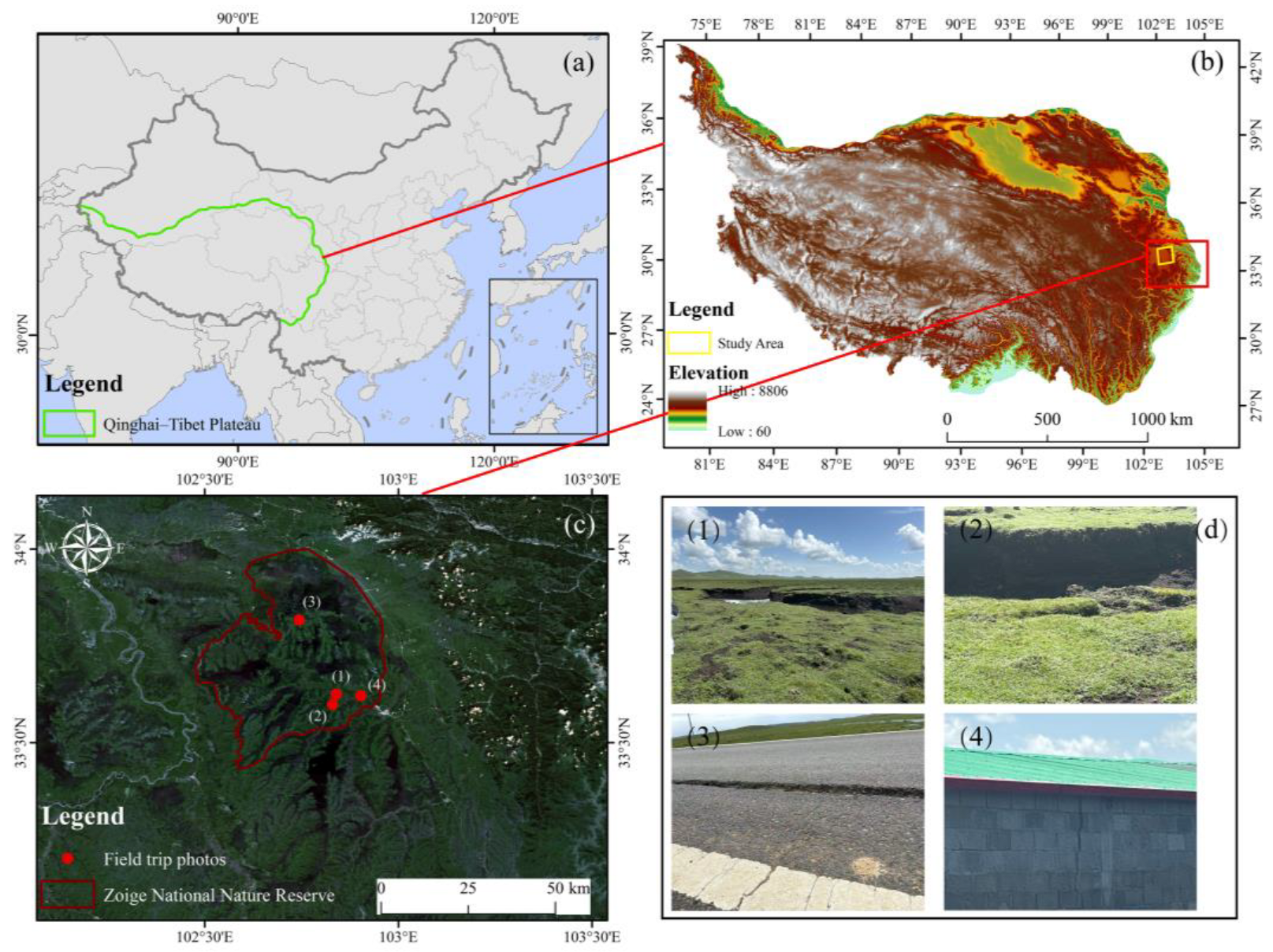
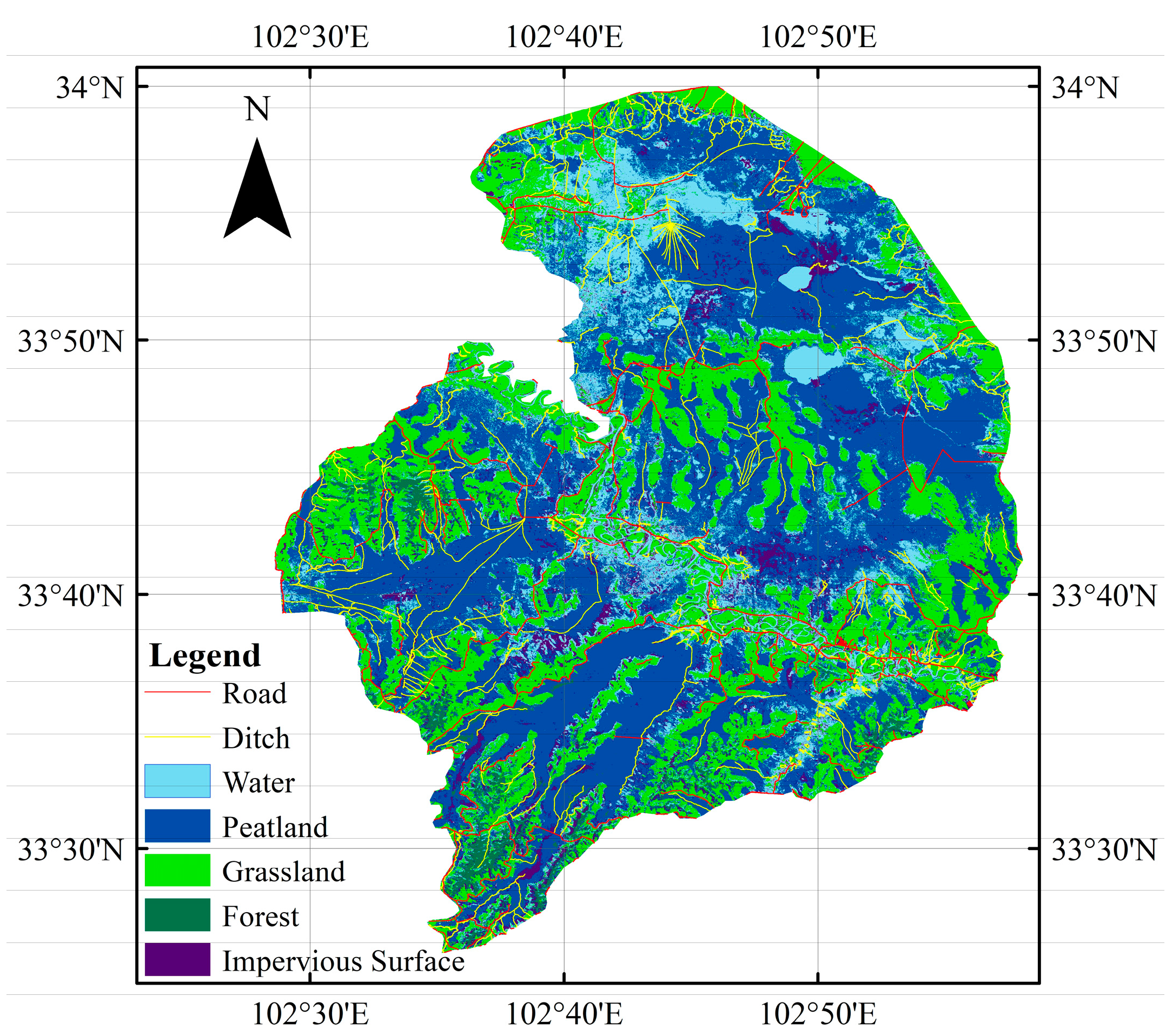
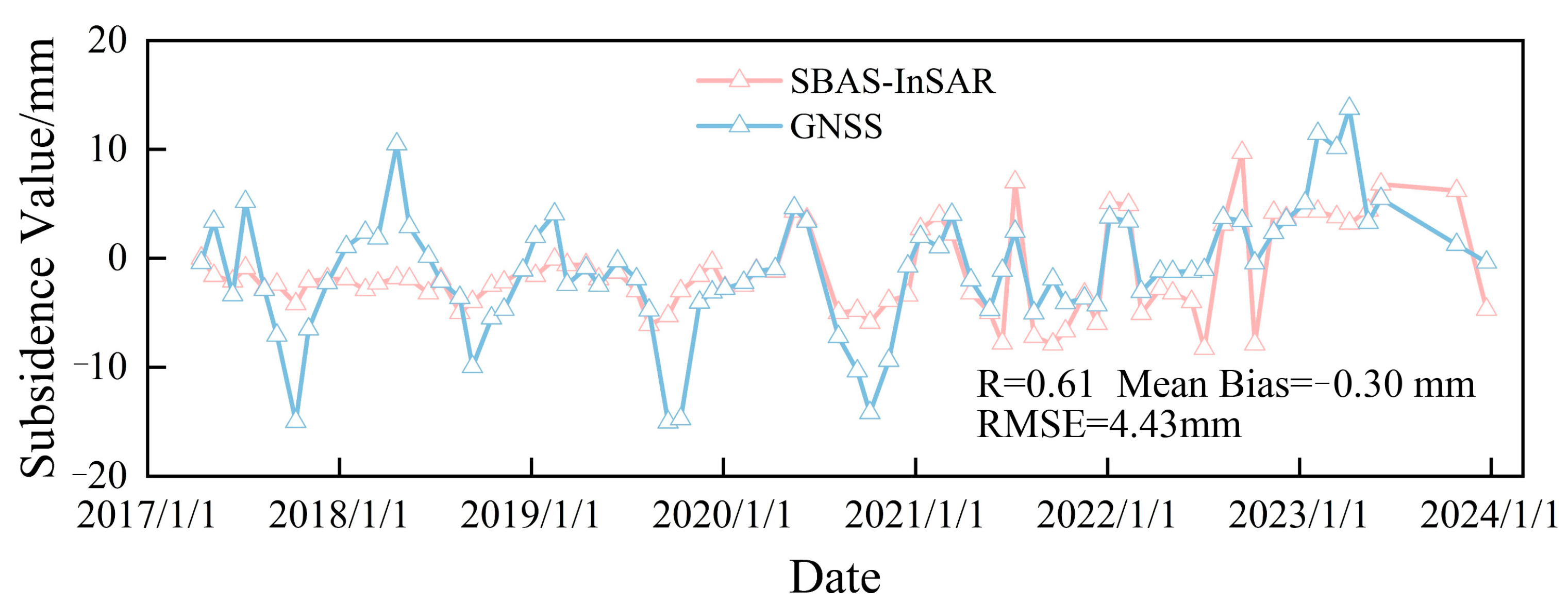

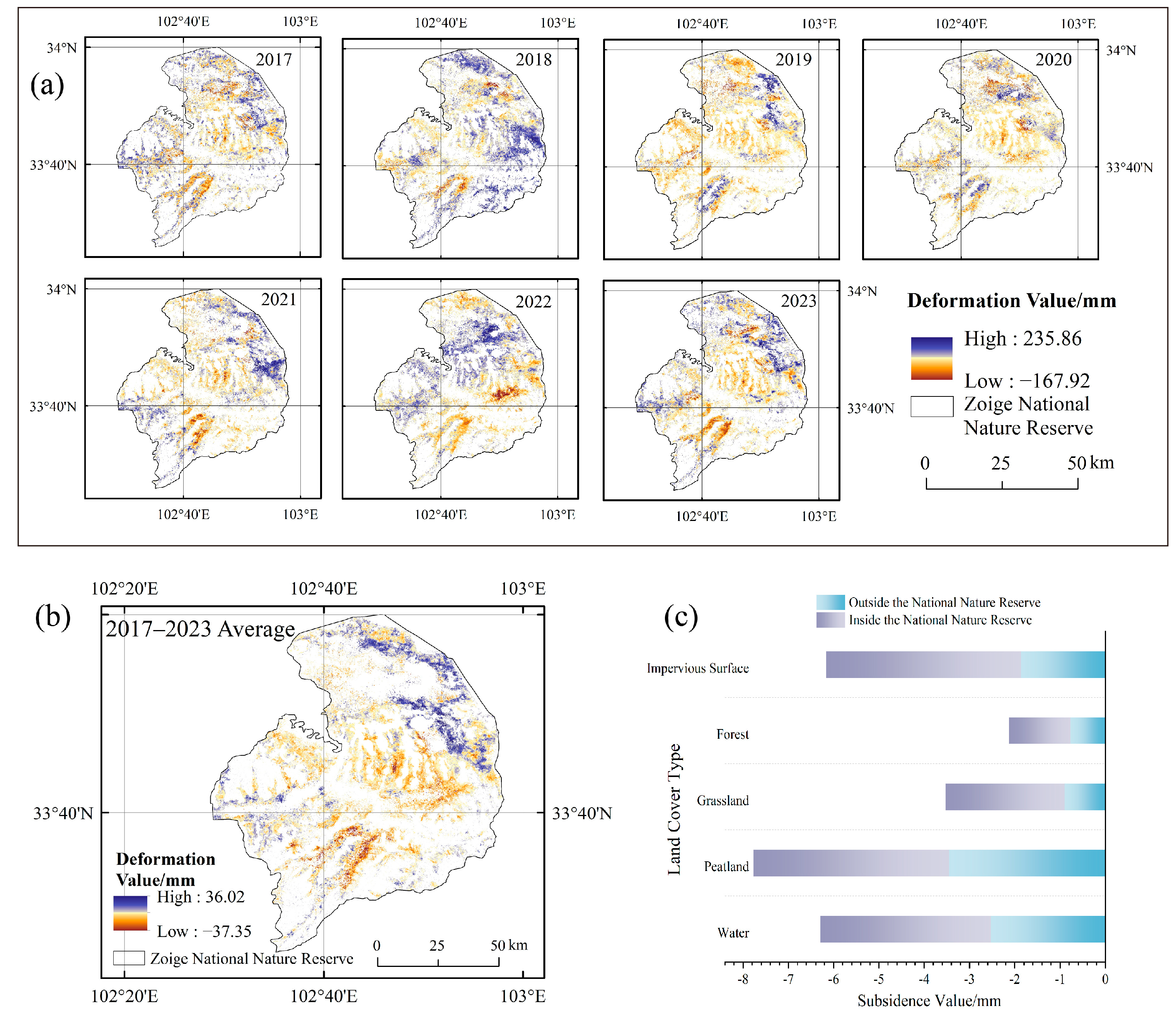
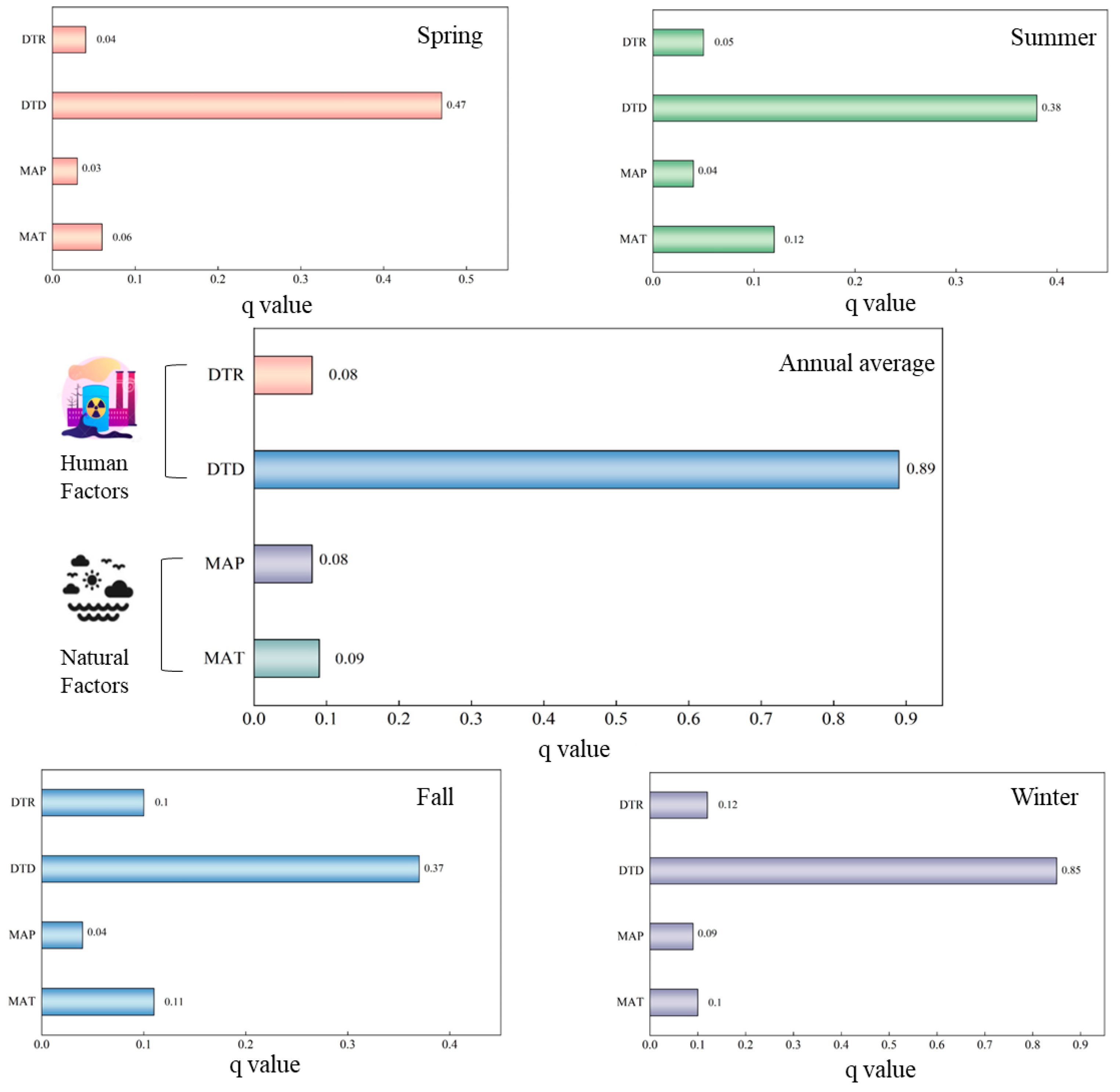

| Data | Source | Formula | Description |
|---|---|---|---|
| B2 | Sentinel-2 | - | Blue (492.4 nm) |
| B3 | Sentinel-2 | - | Green (559.8 nm) |
| B4 | Sentinel-2 | - | Red (664.6 nm) |
| B5 | Sentinel-2 | - | Vegetation Red Edge (703.9 nm) |
| B6 | Sentinel-2 | - | Vegetation Red Edge (740.2 nm) |
| B7 | Sentinel-2 | - | Vegetation Red Edge (782.5 nm) |
| B8 | Sentinel-2 | - | NIR (832.8 nm) |
| B8A | Sentinel-2 | - | Narrow NIR (865 nm) |
| B11 | Sentinel-2 | - | SWIR (1613.7 nm) |
| NDVI | Sentinel-2 | Normalized Vegetation Index. Detecting Vegetation Growth Status, Vegetation Cover and Eliminating Partial Radiation Errors, etc. [45] | |
| NDWI | Sentinel-2 | Normalized water index. Extraction of vegetation water information based on water absorption characteristics in the near-infrared and short-wave infrared ranges, and light penetration in the near-infrared range [46] | |
| ARI | Sentinel-2 | Anthocyanin Reflectance Index. An index of sensitivity to anthocyanin pigments in plant leaves, often associated with plant stress or senescence [47] | |
| PSRI | Sentinel-2 | Vegetation Decay Index. Detecting plant initiation and senescence using carotenoid to chlorophyll ratios [48] | |
| REIP | Sentinel-2 | Red edge tilt points. Approximation of the hyperspectral index used to estimate the position of the NIR/red inflection point in the vegetation spectrum [49] | |
| SDWI | Sentinel-1 | In (10 × VV × VH) − 8 | Sentinel-1 Dual-Polarized Water Index. The proposed SDWI (Sentinel-1 Dual-Polarized Water Index) water body information extraction method based on Sentinel-1 satellite data containing C-band synthetic aperture radar for the identification of water body information on a large scale [50] |
| VV | Sentinel-1 | - | Polarized radar backward scattering coefficient. Vertical polarization sends decibel backward scattering from vertically polarized receiving SAR. The polarization of electromagnetic waves is sensitive to the dielectric constant, physical properties, geometry and orientation of the target, and thus polarization measurements can greatly improve the acquisition of various information about the target by imaging radar |
| VH | Sentinel-1 | - | Polarized radar backward scattering coefficient. Decibel backscatter from vertically polarized transmitter and horizontally polarized receiver SARs |
Disclaimer/Publisher’s Note: The statements, opinions and data contained in all publications are solely those of the individual author(s) and contributor(s) and not of MDPI and/or the editor(s). MDPI and/or the editor(s) disclaim responsibility for any injury to people or property resulting from any ideas, methods, instructions or products referred to in the content. |
© 2025 by the authors. Licensee MDPI, Basel, Switzerland. This article is an open access article distributed under the terms and conditions of the Creative Commons Attribution (CC BY) license (https://creativecommons.org/licenses/by/4.0/).
Share and Cite
Tian, E.; Xue, Z.; Wu, Y.; Song, K.; Li, R.; Zhang, R. Subsidence in Qinghai—Tibet Plateau Peatlands Driven by Drainage Disturbance and Climatic Variability. Geosciences 2025, 15, 407. https://doi.org/10.3390/geosciences15110407
Tian E, Xue Z, Wu Y, Song K, Li R, Zhang R. Subsidence in Qinghai—Tibet Plateau Peatlands Driven by Drainage Disturbance and Climatic Variability. Geosciences. 2025; 15(11):407. https://doi.org/10.3390/geosciences15110407
Chicago/Turabian StyleTian, Enpeng, Zhenshan Xue, Yanfeng Wu, Kaishan Song, Ruxu Li, and Rongyang Zhang. 2025. "Subsidence in Qinghai—Tibet Plateau Peatlands Driven by Drainage Disturbance and Climatic Variability" Geosciences 15, no. 11: 407. https://doi.org/10.3390/geosciences15110407
APA StyleTian, E., Xue, Z., Wu, Y., Song, K., Li, R., & Zhang, R. (2025). Subsidence in Qinghai—Tibet Plateau Peatlands Driven by Drainage Disturbance and Climatic Variability. Geosciences, 15(11), 407. https://doi.org/10.3390/geosciences15110407








